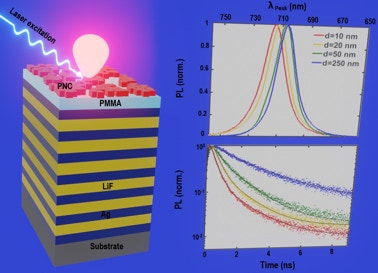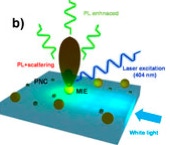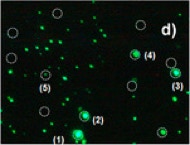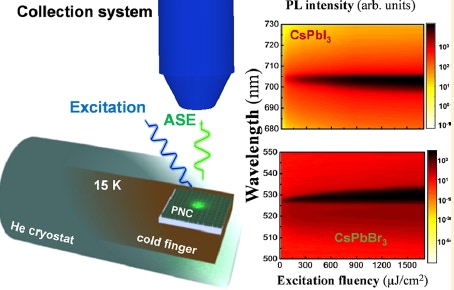NEWS

H. Pashaei Adl, S. Gorji, M. Karimi Habil, I. Suárez, V. S. Chirvony, A. F. Gualdrón-Reyes, I. Mora-Seró, L. M. Valencia, M. de la Mata, J. Hernández-Saz, S. I. Molina, C. J. Zapata-Rodríguez, J. P. Martínez-Pastor,
Purcell enhancement and wavelength shift of light emitted by CsPbI3 perovskite nanocrystals coupled to hyperbolic metamaterials
ACS Photonics, in press (2020).
DOI: 10.1021/acsphotonics.0c01219
Manipulation of the exciton emission rate in nanocrystals of lead halide perovskites (LHPs) was demonstrated by means of coupling of excitons with a Hyperbolic Metamaterial (HMM) consisting of alternating thin metal (Ag) and dielectric (LiF) layers. Such a coupling is found to induce an increase of the exciton radiative recombination rate by more than a factor three due to Purcell effect when the distance between the quantum emitter and HMM is nominally as small as 10 nm, which coincides well with the results of our theoretical analysis. Besides, an effect of the coupling-induced long wavelength shift of the exciton emission spectrum is detected and modeled. These results can be of interest for quantum information applications of single emitters on the basis of perovskite nanocrystals with high photon emission rates.


I. Suarez, T. Wood, J. P. Martínez-Pastor, D. Balestri, S. Checcucci, T. David, L. Favre, J. B. Claude, D. Grosso, A. Gualdrón, I. Mora-Seró, M. Abbarchi, M. Gurioli,
Enhanced nanoscopy of individual CsPbBr3 perovskite nanocrystals using dielectric sub-micrometric antennas
APL Materials 8, 021109 (8 pp) (2020).
We demonstrate an efficient, simple, and low-cost approach for enhanced nanoscopy in individual green emitting perovskite (CsPbBr3) nanocrystals via TiO2 dielectric nanoantenna. The observed three- to five-fold emission enhancement is attributed to near-field effects and emission steering promoted by the coupling between the perovskite nanocrystals and the dielectric sub-micrometric antennas. The dark-field scattering configuration is then exploited for surface-enhanced absorption measurements, showing a large increase in detection sensitivity, leading to the detection of individual nanocrystals. Due to the broadband spectral response of the Mie sub-micrometric antennas, the method can be easily extended to electronic transitions in other spectral regions, paving the way for absorption nanoscopy of many different quantum emitters from organic molecules to quantum dots.

J. Navarro-Arenas, I. Suárez, V. S. Chirvony, A. F. Gualdrón-Reyes, I. Mora-Seró, J. P. Martínez-Pastor,
Single-Exciton Amplified Spontaneous Emission in Thin Films of CsPbX3 (X=Br, I) Perovskite Nanocrystals
J. Phys. Chem. Lett. 10, 6389−6398 (2019).
CsPbX3 perovskite nanocrystals (PNCs) have emerged as an excellent material for stimulated emission purposes, with even more prospective applications than conventional colloidal quantum dots. However, a better understanding of the physical mechanisms responsible for amplified spontaneous emission (ASE) is required to achieve more ambitious targets (lasing under continuous wave optical or electrical excitation). Here, we establish the intrinsic mechanisms underlying ASE in PNCs of three different band gaps (CsPbBr3, CsPbBr1.5I1.5, and CsPbI3). Our characterization at cryogenic temperatures does not reveal any evidence of the biexciton mechanism in the formation of ASE. Instead, the measured shift toward long wavelengths of the ASE band is easily explained by the reabsorption in the PNC layer, which becomes stronger for thicker layers. In this way, the threshold of ASE is determined only by optical losses at a given geometry, which is the single-exciton mechanism responsible for ASE. Experimental results are properly reproduced by a physical model.